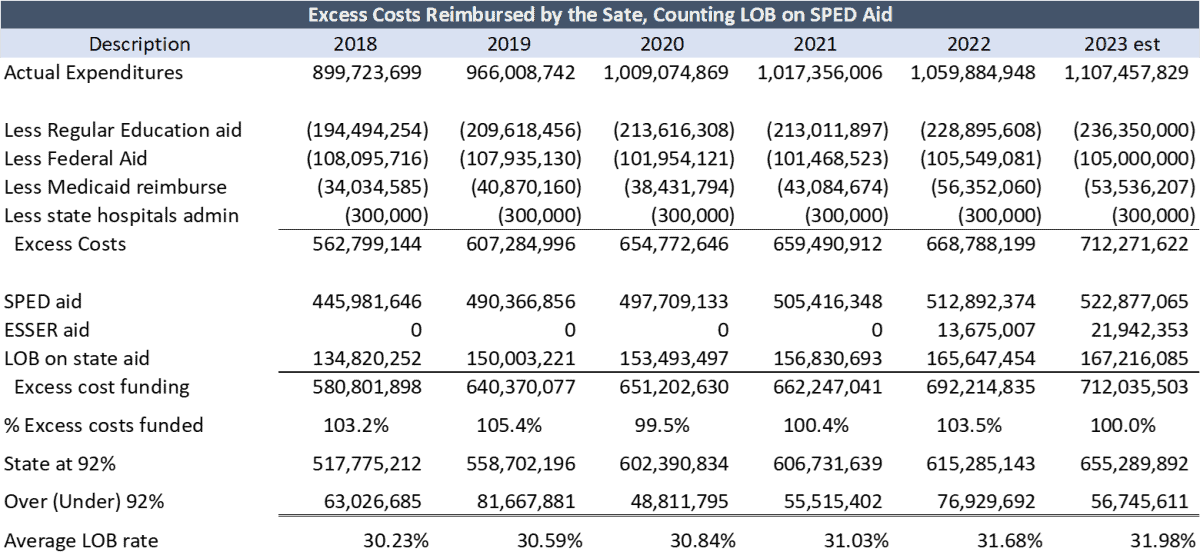Despite testimony that some K-12 funding related to special education (SPED) services is not counted toward SPED funding, the Kansas education bureaucracy called for hundreds of millions more at a recent hearing before the Special Committee on Education.

Kansas State Statute 72-3422 requires the state to reimburse school districts for 92% of their “excess costs” of providing SPED services, defined as costs not covered by federal funding and state aid for the regular education of SPED students.
During testimony, proponents of increased funding bolstered their position by saying districts must offset the shortfall by taking money away from other services for other students. They claim that SPED funding is shortchanged some $200 million currently.
Other testimony refuted claims of districts being underfunded, however. Kansas Policy Institute, the Sentinel’s parent company, cited Department of Education data showing that districts increased their special education cash reserves by almost $48 million between 2018 and 2022. Cash reserves for other operating funds (total less capital outlay, debt service, and federal funds) increased by $185 million.
 KPI’s testimony argued that school districts surely would not have used over $200 million of state and local aid to increase cash reserves if administrators believed there were unmet education needs.
KPI’s testimony argued that school districts surely would not have used over $200 million of state and local aid to increase cash reserves if administrators believed there were unmet education needs.
KPI spokesperson Mike O’Neal and several legislators on the committee also presented evidence that the funding formula is flawed because it doesn’t all the money provided to districts that is related to special education.
In addtion to base state aid, school districts receive “weightings,” which is additional money paid to districts with additional costs from serving certain student populations. Some of the weightings include additional funds for transportation in rural areas, high density at-risk students; those who are at a higher risk of behavioral issues and drop-out rates, bilingual students, those in career and technical education, those districts with new facilities, as well as a special education student population. Special education students are eligible for these weightings, but the formula excludes some of them and KSDE officials don’t know of any reason that all weightings are credited as state aid.
The formula also does not give the state credit for Local Option Budget (LOB) money received that is related to SPED funding. Written testimony from KPI CEO Dave Trabert explained that LOB should be part of the SPED funding formula:
“Special education funding generates LOB money based on each district’s LOB rate, which can go as high as 33%. So, a district with a 33% LOB that gets $1 million in special education aid also collected $333,000 in LOB money from local taxpayers because of its special education funding. For example, schools spent $1.060 billion on SPED in 2022, with excess costs of $668.8 million remaining after allowance for other funding. State aide for SPED was about $512.9 million, which generated $165.6 million in LOB money, and KSDE (Kansas State Department of Education) credits the state with $13.7 million in extra federal funding. That totals $692.2 million, or 103.5% of schools’ excess costs; about $76.9 million higher than the 92% threshold.

“The Legislature provided $383 million more than the 92% threshold on this basis since 2018, and that does not include funding for the weightings excluded in the formula. Counting all funding sources is also consistent with the Kansas Supreme Court ruling from March 2014 on the calculation of adequate funding.
Excluding weightings and LOB money generated by special education funding was likely just an oversight, which happens from time to time when legislation is drafted.”
Committee members appeared skeptical at the funding recommendations from a couple of representatives of the state education establishment, as neither suggested a retooling of the funding formula as a solution.
Craig Neuenswander, Deputy Commission of KSDE offered a recent vote of the Kansas Association of School Boards:
“This summer they recommended in terms of special education, unanimously recommended, that the law be funded as it’s written which would be 92% of excess cost but that that cost be phased in over a four-year time period.”
Committee Chair Rep. Kristey Williams responded:
“I’m genuinely disappointed that they (KASB) only wanted to pour more money on the problem without ever looking at what’s creating the problem.”
KASB Spokesman Scott Rothschild got a similar grilling when he defended his organization’s unanimous vote and asserted:
“I would like to point out special education is the only major part of the school finance formula that isn’t adjusted for changes in need…Of course, it is supposed to – that’s the point of the 92% formula. But because the formula isn’t followed, special education is the only part of the formula that that is funded without regard to changes in statewide need”
Rep. Scott Hill took exception to Rothschild’s statement:
“Your request for funding and the state board’s request for funding is increased every year.”
It was also noted that the state has increased SPED funding each year.
A Special Education and Related Services Funding Task Force comprised of legislators and experts in the field has been named, but has not yet met.


